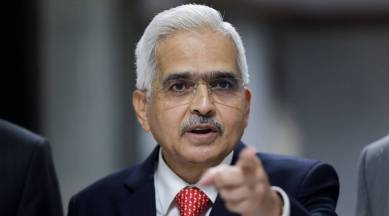Monetary Policy review: Retaining policy rates, RBI cuts growth, ups inflation estimates
Growth projection 7.2%, inflation forecast 5.7%; sets stage for rate hike

The Monetary Policy Committee (MPC) of the Reserve Bank of India (RBI) Friday decided unanimously to leave the key policy rate unchanged and to remain accommodative but will start focusing on withdrawing this stance to rein in inflation while supporting growth.
The repo rate — the rate at which the RBI lends to banks — remains at 4 per cent. Unveiling the first bi-monthly monetary policy review of the fiscal 2022-23, the RBI has introduced the Standing Deposit Facility (SDF) — a new tool for absorbing liquidity – at an interest rate of 3.75 per cent, making the reverse repo almost irrelevant. The SDF will replace the fixed rate reverse repo (FRRR) as the floor of the LAF (liquidity adjustment facility) corridor.
monthly limit of free stories.
with an Express account.
In effect, the RBI has set the stage for a gradual rise in the policy rates later in the year and the process of slowly tightening the monetary policy. Reacting to the RBI’s intent to gradually move away from its loose monetary police stance, the benchmark 10-year government bond yields on Friday jumped to near three-year highs to close at 7.12 per cent against the previous day’s close of 6.91 per cent.
With crude oil and commodity prices rising, the central bank has hiked its inflation projection for fiscal year 2022-23 to 5.7 per cent from 4.5 per cent earlier amid geopolitical tensions following Russia’s attack on Ukraine on February 24. Global crude oil prices have risen sharply since then, and the RBI has assumed oil prices at $100 per barrel for making the inflation projection.
The monetary policy statement has also acknowledged the challenges from rising inflation. Emphasising this at a press conference, RBI Governor Shaktikanta Das said, “In the sequence of priorities, we have now put inflation before growth. Time is appropriate to prioritise inflation ahead of growth.”
The central bank has also slashed (adjusted for inflation) the gross domestic product (GDP) growth projection to 7.8 per cent for FY2022-23 compared with 7.2 per cent earlier. “With the broad-based surge in prices of key industrial inputs and global supply chain disruptions, input cost push pressures appear likely to persist for longer than expected earlier,” the policy panel said.
Escalating geopolitical tensions have cast a shadow on our economic outlook, RBI Governor Das said. Although India’s direct trade exposure to countries at the epicentre of the conflict is limited, the war could potentially impede the economic recovery through elevated commodity prices and global spill-over channels, he said.
“The ratcheting up of geopolitical tensions, generalised hardening of global commodity prices, the likelihood of prolonged supply chain disruptions, dislocations in trade and capital flows, divergent monetary policy responses and volatility in global financial markets are imparting sizeable upside risks to the inflation trajectory and downside risks to domestic growth,” the RBI said in its statement.
“The government’s thrust on capital expenditure coupled with initiatives such as the production linked incentive (PLI) scheme should bolster private investment activity, amidst improving capacity utilisation, deleveraged corporate balance sheets, higher offtake of bank credit and congenial financial conditions,” it said.
According to Das, since the MPC’s last meeting in early February 2022, the expected positive benefits from the ebbing Omicron wave have been offset by the sharp escalation in geopolitical tensions. This has significantly changed the external and domestic landscape. Concerns over protracted supply disruptions have rattled global commodity and financial markets, he said.
“At the same time, the escalation of the geopolitical situation and the accompanying surge in international crude oil and other commodity prices, tightening of global financial conditions, persistence of supply-side disruptions and significantly weaker external demand pose downside risks to the outlook,” he said.
“The RBI monetary policy announcement is a pragmatic assessment of the current uncertain economic environment,” State Bank of India Chairman Dinesh Khara said. The RBI has rightfully re-calibrated the growth and inflation numbers and announced a slew of measures to support the government borrowing program in a non-disruptive manner, he said.